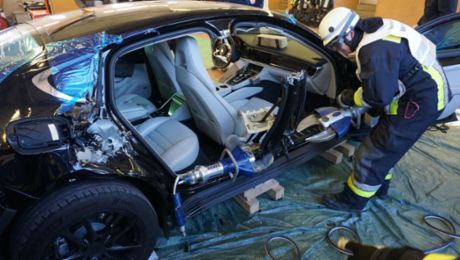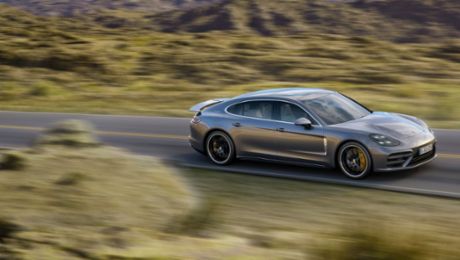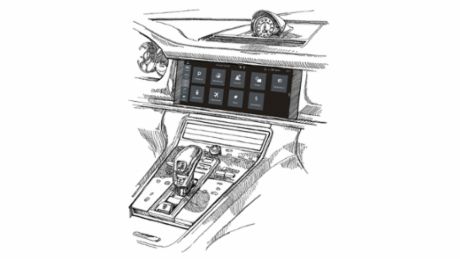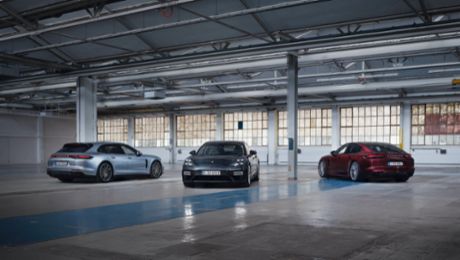It’s not often that a passenger rises to the level of a rally-style codriver. The ideal codriver is there whenever you need them—authoritative, but not bossy. They know the terrain like the back of their hand, warn you in time of sharp turns, or give the all-clear to floor it when the road permits. If desired, a codriver just like that is available at any time in the new Porsche Panamera 4S—a virtual codriver, if you will. With Porsche InnoDrive (PID), the engineers in Weissach have created an assistance system with capabilities that extend far beyond those of other electronic aids. InnoDrive controls the speed and transmission settings and can plan up to two miles ahead.
Thanks to highly precise navigation data, the comfort assistant not only knows all about the route and speed limits, but also knows the exact topography (i.e., the elevation profile, corner radii, and gradients). Using this information, it continuously calculates the ideal driving profile, selects the optimal gear, and initiates acceleration and braking. The double-clutch transmission is integrated and controlled in a forward-looking manner. The result is a drive that is not only noticeablysmoother than when the driver operates the gas and brakes, but also more efficient and often faster as well.
Markschläger: “You have to take the plunge with InnoDrive"
Philip Markschläger knows InnoDrive as well as anyone. As the project manager, he was in charge of the development of the system. “You have to take the plunge with InnoDrive, for starters,” he says, lifting both feet from the pedals as the dark-blue Panamera glides rapidly toward a roundabout. “But in trials it soon became clear: that happens pretty quickly.” The starting point for the test-drive was Zuffenhausen. Just beyond the gates of the plant, the engineer taps the little switch to the left of the steering wheel and the “PID” icon on the digital speedometer goes from white to red. The roundabout is the first test—but the Panamera knows exactly what to do. It briefly brakes before the traffic circle, swiftly drives halfway around, and accelerates moderately after pulling out. Markschläger’scontribution is merely steering, watching for oncoming traffic, and switching the turn signals on and off. The pedals remain untouched.
Before long the InnoDrive display is announcing the next roundabout. The driver puts the system to the test, taking a second lap. InnoDrive instantly grasps the situation and continues circling at a constant speed. The car makes one, two laps before Markschläger signals and pulls out of the loop. The system responds with slight braking followed by powerful acceleration. The control unit knows about the steep incline just after the corner and ascends it with ease. It also knows about the long flat stretch at the top. The Panamera lays down the head of steam it’s gathered on the straightaway and cruises elegantly down the road to the next town. It passes the city limits sign at roughly 30 mph and leisurely rolls past the speed camera lying there in wait.
A trinity of speed, efficiency, and comfort
The question Markschläger and his team asked themselves at the outset of their work was what the optimal acceleration is. Is the ideal acceleration one that provides for high average speeds? Or is it acceleration that minimizes consumption? Or is it when the car’s occupants feel especially comfortable? Somewhere between these three parameters—speed, efficiency, and comfort—lies the solution for optimal acceleration.And that solution looks considerably different than one’s intuition might suggest.
Flashback to May 2011, south of Berlin, at the Challenge Bibendum. The competition was established to promote sustainable mobility solutions, and Porsche came in second place in a 911 Carrera. The 911 impressed not only with its lap times, but also with its consumption values. The standard flat-six engine stayed roughly under 1.6 gallons per 62 miles. A radical, ingenious driving strategy devised in Weissach made it possible: the driver floors the gas pedal, then disengages and coasts with the engine switched off for as far as possible.
“It’s hard to believe, but it’s actually more fuel-efficient to accelerate hard and then use the energy proactively,” explains Markschläger. There’s just one catch: it makes for an unpleasant drive. Yet the insights from the Challenge Bibendum are present in the InnoDrive algorithm as efficiency parameters. As a luxury touring sedan, comfort is high on the list of the Panamera’s priorities. Instead of brute acceleration and shifting, the engineers taught the system to drive smoothly and with as little jerking as possible. And as the third element, in keeping with the Porsche motto of intelligent performance, the highest possible speed is plugged into the equation.
Millions of options—and a single optimal one
The additional variables are provided by the route: gradient and curve radii, straightaways and city boundaries are all read from high-resolution navigation data while a camera also reads speed limit signs, etc. The current wind and rolling resistance go into the calculation as well, and continuously feed the system with information. Last but not least, InnoDrive responds to every steering maneuver by the driver and adjusts its planning accordingly, as in the spontaneous lap of honor around the roundabout.
Roughly two times a second, the control unit provides an update: a completely recalculated version of the driving profile and the ideal trajectory for the next two miles. InnoDrive selects from countless transmission states (eight gears and coasting) and determines countless acceleration options. “This continuously gives us millions of options for the driving strategy,” says Markschläger. But the computing power required for this is immense. So, along with his team, he adapted the dynamic programming computing method—an optimality principle developed by mathematician Richard Bellman—until it could support real-time capability in the car. “Essentially, the idea is to recognize at an early stage which paths cannot possibly lead to the optimal solution,” and then to discard them without running through the whole calculation.
Meanwhile, Markschläger has guided the Panamera onto the Weissach circuit, the homeland of InnoDrive. For more than five years and over thousands of miles the engineers have tested the system there, initially using route information from the state land surveying office. “For $5.34 every 0.4 square mile!” says Markschläger, laughing. At the time, InnoDrive’s world ended just outside the villages around the Porsche Development Center in Weissach. Since then, it has become ready for use in most of western Europe as well as the United States, and more countries are being added all the time. Its great strength is increasing comfort on trips, be they on rural roads or on the highway. A Gran Turismo like the Panamera is therefore perfect for the InnoDrive system, but in principle the system can be extended to any other model as well.
Normal vs. Sport
That’s not all InnoDrive can do. On a country road, Markschläger flips the switch on the steering wheel to Sport and suddenly the codriver’s sporty side side surfaces. The Panamera punches through the switchback on the way out of town, races up hills, and bounds through a series of sharp turns with an unmistakable spring in its step. You can hear and feel the rotational speed. “In Sport mode, the priorities are rearranged,” explains the engineer. “Speed is the first concern, while comfort and efficiency take a bit of a backseat.” InnoDrive now puts out some twenty percent more acceleration and twenty percent more lateral acceleration in corners.
Markschläger switches back to Normal mode. Now the Panamera coasts down the gradual downhill stretch through the forest beneath the autumnal foliage and past an old mill. Wintry rays of sunshine dance across the dashboard. This is a calm, relaxing state of driving; the gentle curves are all but imperceptible. In the towns, InnoDrive is not much use, as there are too many stop signs, intersections, and traffic lights that were deliberately not implemented. “The driver has to know the limits of the system,” says Markschläger as he brakes at an intersection to let a truck pass. “The driver always has to be aware of traffic. InnoDrive is a comfort assistant, not an autonomous driving function.” Any manual braking maneuver immediately deactivates the assistant, while any manual acceleration temporarily overrides it. And the codriver can be silenced with the push of a button, for moments when the driver wishes to be alone on the road with their Porsche for a spell.
Info
Text first published in the Porsche customer magazine Christophorus, No. 380
Text by Bernd Eberhart // Photos by Christian Grund
Consumption data
Panamera 4S: Fuel consumption combined 8.2 – 8.1 l/100 km; CO2-emissions 186 – 184 g/km
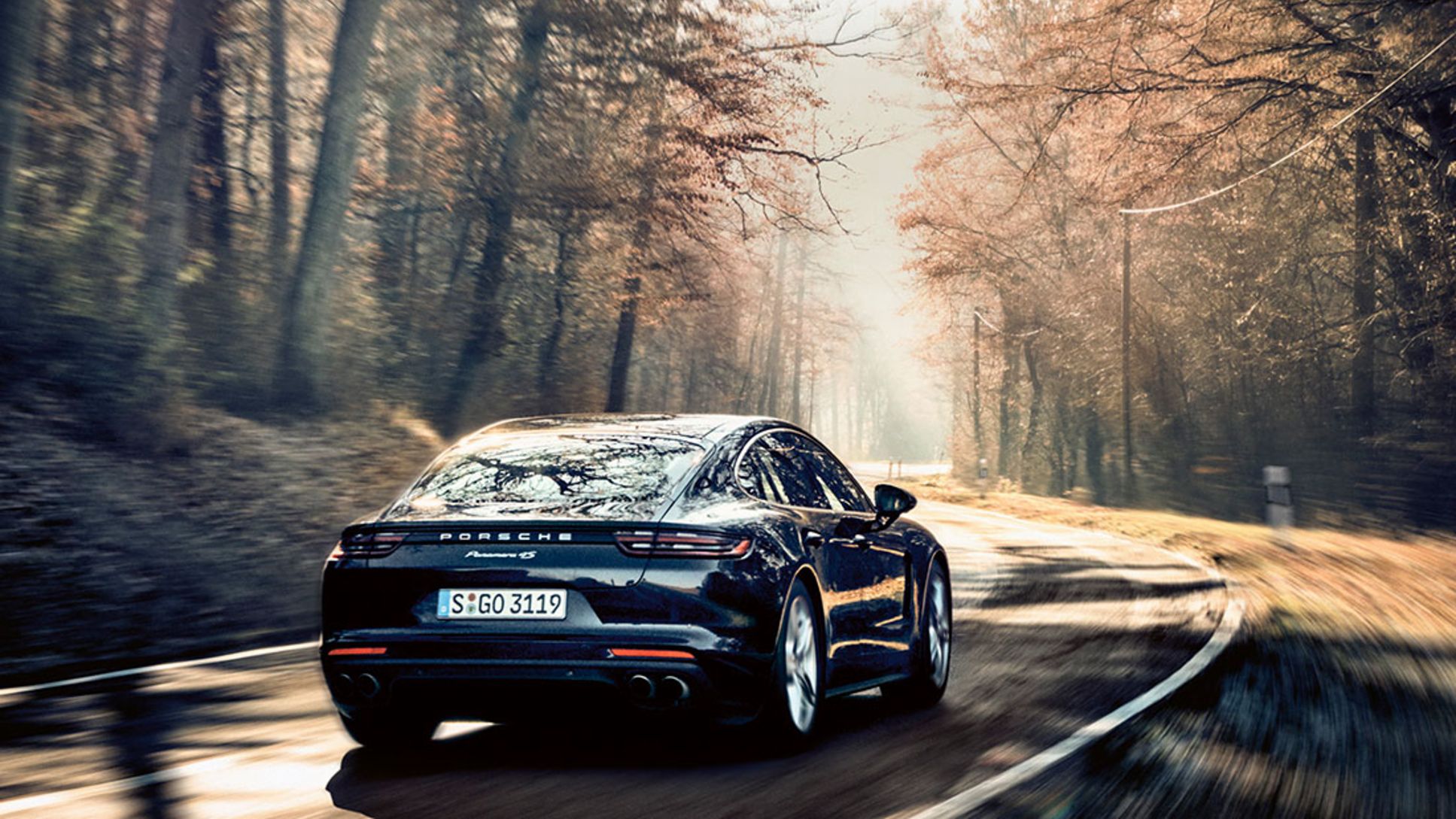
.jpg/jcr:content/b-InnoDrive-(illustration).jpg)
.jpg/jcr:content/b-Porsche-Panamera-4S-(3).jpg)

